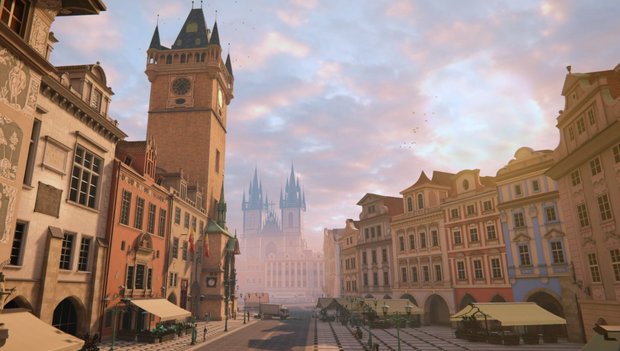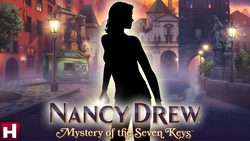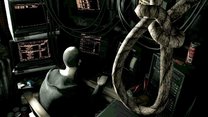Nancy Drew: Mystery of the Seven Keys review

- 3 Comments
The teen sleuth returns with puzzles aplenty, though much of scenic Prague is left locked and inaccessible
Nancy Drew is back! After a detour into more casual and character-based choice-driven gameplay in 2019’s Midnight in Salem, followed by a much-longer-than-usual wait for a sequel, HeR Interactive has returned to its roots with the thirty-fourth Nancy Drew game, Mystery of the Seven Keys. This time, Nancy’s off to Prague to stop a gem-stealing racket. Alchemy, computer hacking, marionettes, and even a touch of the supernatural await in this node-based slideshow game or real-time first person explorer (your choice!). Though the narrative is thin and it doesn’t let players explore much of its historic setting, the renewed emphasis on puzzles should be welcome news to fans of classic Nancy Drew.
Nancy starts her latest case already in Prague at the Hungerkünstler Café. There she meets her client, Adela Čzerná, a young woman wanting to sell her deceased mother’s antique jeweled necklace. Only, when Adela took the necklace to a third-party intermediary to sell, the report came back claiming that all the jewels were fakes. Now Adela wants Nancy’s help to retrieve the stolen gems. After a brief interface tutorial at the café, the world opens up so Nancy can get on with the case proper.
The café is situated across the square from St. Vitus Cathedral, which Nancy gets to see but never goes inside. Instead she has access to a somewhat austere museum with a small jewelry store attached, another square with the great Prague astronomical clock tower, which she also doesn’t get to enter, and a small shop that is half electronics outlet and half historical curio cabinet. These locations encompass nearly everywhere Nancy goes in the game. While the settings have a nice amount of detail, there are so few that after thirteen hours of play time they do start to get a bit boring. A couple of small additional places open up at certain points later on, but I found constantly retreading the same main scenes really undermined any sense that I was making progress. With the seven titular keys required to gain access to the crown jewels of Prague, I expected to be visiting all manner of sites within the historic city, but that never materialized.

To be sure, the game does throw a lot of history at you. You can spend a good chunk of time at the museum reading various signs about Prague’s past. It’s all pretty dry stuff, but it pays to take note of it as some of the information is needed for puzzles. Nancy comes equipped with a cell phone she can use to take pictures, but the puzzles, being largely mechanical in nature, typically go into dedicated close-up views to solve, within which you cannot access Nancy’s phone. So that means you’ll have to resort to writing down all the esoteric facts and drawing all the intricate alchemical symbols you encounter with pen and paper to see them when you need them most.
One aspect of the history lessons I enjoyed was presented in a marionette show. Here you have to help local marionette artist Radek put on his show about the royal succession in Prague. Using vague stage directions, you have to determine which puppets are needed and which props they should be carrying for the various scenes in the show. This sequence places you squarely in the midst of history in the making (or at least remaking), and is far more engaging than any of the static text museum displays.
Most of the other puzzles are pretty typical fare involving pattern matching, deciphering of codes, and mathematics, the results of which are then used for combinations to a variety of mechanical puzzles. Most of these challenges are multi-layered, involving bringing together disparate clues to make them work. Unfortunately, the game provides zero feedback when you get a puzzle wrong beyond the basic, “that doesn’t work,” if you’re lucky.

While that’s not unique to Mystery of the Seven Keys or even the Nancy Drew series in general, compounding the issue here is that the game breaks faith with players on more than one occasion. In one example, you need to open a secret door by correctly placing tiles with different images on them into a grid on the wall. Next to the grid are partial clues that indicate such things as a sword going above the symbol of a square with a crown in it. The problem is that multiple valid solutions exist, but the game only accepts a particular one, with nothing to differentiate it from the others. This is the mechanical puzzle equivalent of needing to cut a rope and having scissors, a knife and a machete, but only the hacksaw will actually work.
Even finding puzzles in the game can be a chore. I initially started the game on the Master Sleuth difficulty setting. After playing for nearly an hour and not even making it out of the café tutorial, I abandoned that playthrough and switched to Amateur Sleuth. It wasn’t that the puzzles were too challenging, although they are more complicated on the harder level, as much as there was almost no direction as to what exactly I was supposed to be doing next. On the easier setting, Nancy’s cell phone comes with a rather prescient task list, which is absent on the harder difficulty level.
The task list tells you where you should be looking next or which character you should talk to. This may not seem like a big thing, but there are several points in the game where characters who really shouldn’t know something just suddenly, arbitrarily do, and the game gives you no indication this has happened. One example involves a scale model of the great Prague clock tower, which functions in its own special way. At one point, Nancy has to figure out how to set a particular day and time on it. I expected to ask one of the locals about the clock; maybe Patricie, the owner of the café where the model resides. Or perhaps check with Oskar, the curator at the museum, about all things historical in Prague. Nope. [small spoiler alert, but you’ll thank me] The person who comes through in the clinch is Nancy’s boyfriend Ned Nickerson, who is only available via cell phone text or call.
Even with the overt direction provided by the task list in the phone, much of the case feels like Nancy just rambling around rather aimlessly. Occasional moments of intrigue pop up, such as when Nancy needs to hightail it to find the exit in a maze-like tunnel system while being chased by a mobile cloud of black smoke. If it catches her, it’s game over, although a handy “Second Chance” button allows the sequence to be reset. However, any elements that hint at something larger going on are few and far between. It’s only really in the last hour that the narrative pulls together into something cohesive, although the revelation of whodunit doesn’t particularly come as a surprise. Despite the sense of a grander conspiracy being afoot, the final solution is rather mundane. Not bad, just not as dramatic as the rest of the game indicated it might be.

Visually Mystery of the Seven Keys is quite nice, with the front of the cathedral and the clock tower in particular exhibiting a great deal of grandeur and detail. It’s impressive to just stroll around for a few minutes and take in these two magnificent pieces of architecture. The rest of the game undercuts the experience slightly, though, as most interior locations are rather generic. The café, jewelry shop, and electronics store could be stops in any Western city in the world. Even the museum feels rather sterile, essentially consisting of one room that’s little more than a big box with a few sad displays in it.
Character models range from generic, like Radek the marionette performer, to somewhat expressive, like Patricie, the café owner. The latter is an elderly lady with a round, inviting face and something of a sparkle in her eye. The former could have been the stock twenties-to-forties male 3D model in any asset pack available from a game development shop. One noticeable improvement with the characters from the previous game is that much more attention has been spent on the lip sync. In Midnight in Salem, the sync was all over the place. In Mystery of the Seven Keys it is bang-on every time.
Most of the characters are well acted with appropriate-sounding accents, at least to these North American ears. Radek, a native of the city, again is underwhelming as no attempt has been made to give him an accent. There’s a little hand-waving dialog about how he attended North American schools, but it feels like a bit of a lazy explanation. Sadly, the weakest performance comes from Nancy Drew, which is a shame because I really enjoyed Brittany Cox in the role last time. In the previous game, she was paired much of the time with a frenemy with whom she could banter and stretch out into the part more. Here Nancy is flying solo and has no real emotional connection to any of the main players in the case. The result is that she comes across a little flat and robotic, which is particularly ironic as at one point she has to complete a computer captcha and truly makes her voice robotic as she says, “I am Nancy Drew, I am not a robot,” to make fun of the verification system. Occasionally, such as when she must escape the pursuing black smoke, she has more emotional moments and those play very well. Most of the time, though, it’s very dry detective dialog.
Nancy’s investigation is accompanied by repeating background music, a generic investigatory score that I found myself tuning out, which is probably a good thing given how short the loops are. The one change to this pattern occurs in the game’s couple of chase sequences, where the track becomes much more up-tempo and tense. But while the music only falls into the “it’s all right” category, the sound effects are quite good, especially in the museum, where it’s possible to take a “haunted tour.” Fog machines and darkened lighting definitely achieve a mood, but the sound absolutely enhances it with eerie cries and the thud of disembodied footsteps drawing ever closer.
No review of Mystery of the Seven Keys would be complete without mention of some of the game’s quality-of-life features. For fans of the classic Nancy Drew mysteries, node-to-node point-and-click navigation can be chosen to emulate how those older games played. Meanwhile, the “Modern” setting allows for freely roaming about the locations in real time. I do wish there was a toggle run button, but just ungluing Nancy’s feet felt like a big step forward to me. Also on offer in the Amateur Sleuth mode is an in-game hint system, which provides increasingly specific clues. Even so, a couple of puzzles forced me to resort to a separate guide for answers, and for one of those I’m still not sure why the solution is what it is. Regardless, one final boon in this game is its save system, offering both a progressive autosave and the ability for players to freely record their progress at will. This is what a save system in an adventure game should be.
Final Verdict
After something of a detour in the previous game, Nancy Drew: Mystery of the Seven Keys harkens back to the play style of the classic Nancy Drew series by downplaying its storytelling and character aspects in favour of a greater focus on multi-layered, challenging, mechanical puzzles. Most of these are pretty standard symbol-deciphering affairs with the occasional novel diversion, like conducting the marionette show, adding spice to the proceedings. A few of them are a touch obscure, and direction on what to do in between can sometimes be overly vague, which can be accentuated or mitigated through the game’s two difficulty settings. And for the first time ever, being able to choose point-and-click or free movement affords the game a nice degree of customizability. Ultimately, how enjoyable you find the experience to be comes down to nostalgia and what you’re looking for. If you’re after an intriguing detective mystery with twists and turns and eclectic characters, this one doesn’t quite scratch that itch. However, if you’re a fan of the more puzzle-centric pre-Midnight in Salem games, then this will surely be seen as a nice course correction.
Hot take
After a long hiatus, the perennially youthful Nancy Drew is back in Mystery of the Seven Keys. The pendulum has swung back from the greater focus on story and character interaction in the previous installment, but fans of the classic series will doubtless welcome the renewed emphasis on puzzle solving this time around.
Pros
- Challenging, multi-layered mechanical puzzles
- Solid voice acting for most characters
- Well-done soundscape, especially in the spooky bits
- Impressively detailed real-world locations
- Options to play in slideshow mode or free movement mode
Cons
- Some puzzles are poorly designed
- Not enough location variety for such a lengthy game
- Nancy doesn't sound particularly engaged
- The mystery could be a bit more mysterious
- Lack of adequate direction on the harder difficulty level
Richard played Nancy Drew: Mystery of the Seven Keys on PC using a review code provided by the game's publisher.











3 Comments
Want to join the discussion? Leave a comment as guest, sign in or register in our forums.
Loved this game! After Midnight in Salem, it felt a return to the feel of the early ND games that made me fall in love with the series. 100% agree with your broad takeaways. in my opinion, the ND games are at their best when they have a unique setting and challenging but solvable puzzles, and this game was very good on both counts.
Reply
i love these games, but this was one of the worst i’ve played… very disappointing
Reply
I have played every single one of the Nancy Drew series. I put up with Midnight in Salem (using walkthru hints) and looked so forward to this one coming out. What a major disappointment! Whatever you do...don't play Master Sleuth - you need the hints! I'm not a stupid person, but this was impossible for me to figure out from the beginning to the...I can't even say end because I can't make myself finish it! Don't waste your money!
Reply
Leave a comment